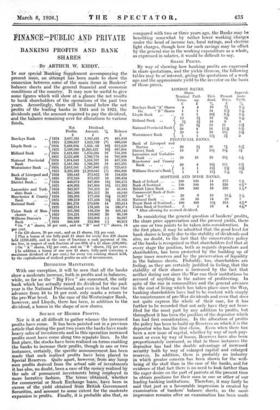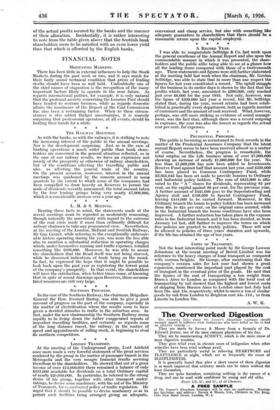FINANCE-PUBLIC AND PRIVATE
BANKING PROFITS AND BANK SHARES i-BY ARTHUR W. KIDDY.: IN our special 'Banking Supplement accompanying the present issue, an itterupt has been made to show the connexion' betWeen. some of the. main items in. Bankers' balance sheets and the general financial and economic conditions of the country. It may now be useful to give some figures which will show at a glance the net results to bank shareholders of the operations of the past two years. Accordingly, there will be found below the net profits of the leading banks in 1924 and in 1925, the dividends paid, the_amount required to pay the dividend, and the balance remaining over for allocations to various funds.
Balance 1925 178,500 14 190,874 * On " A " shares, 10 per cent., and on " B " and " C " shares, 14 per cent.
f On £20 shares, 20 per cent., and on £1 shares, 121 per cent. Plus a bonus of one fully-paid £1 share for every five £20 shares held (V68,439), and in the case of fractions a cash payment of 10s. tax free, in respect of each fraction of one-fifth of a £1 share (V6,000). fl On " A " shares, 131 per cent., and on " B " shares, 121 per cent. § In addition a bonus of one new £1 share, fully-paid (carrying a maximum dividend of 5 per cent.) for every ten existing shares held, by the capitalization of realized profits on sale of investments.
DIVIDENDS MAINTAINED.
With one exception, it will be seen that all the banks show a moderate increase, both in profits and in balances, while, so far as the " Big Five " are concerned, the only bank which has actually raised its dividend for the past year is the National Provincial, and even in that case the advance from 16 to 18 per cent. only marks a return to the pre-War level. In the case of the Westminster Bank, however, and Lloyds, there has been, in addition to the dividend, a bonus in the shape of new shares.
SOURCE OF HIGHER PROFITS.
Nor is it at all difficult to gather whence the increased profits have come. It has been pointed out in a previous article that during the past two years the banks have made heavy sales of investments and in this"Operation increased profits must have come along two separafe lines. In_the first place, the stocks have been realized on terms enabling the banks to increase their profits, though in one or two instances, certainly, the specific announcement ,has been made that such realized profits haV'e been Placed to Special Reserves. Quite apart, however,:froin any-lump sum profits derived from the actual sale of investments it has also, no doubt, been-a_ case of the money-realized by the sale of permanent investments beirig -eniploye.d in more lucrative fashion. The terms: obtained, ' ivhethir for commercial or Stock Exchange • loiths;_ have been in excess of the yield obtained from British Government Securities, and account to some extent for the moderate expansion in profits. Finally, it is probable also that, as
Barclays Bank Lloyds Bank .. Midland Bank National Provincial Bank Westminster Bank Bank of Liverpool and Martins .. District Bank.. Net Dividend.
Profits. Amount. %
£ £ 2,067,281 1,585,431(5) 2,289,837 1,623,789 (5) 2,468,934 1,856,.-.06 161 2,569,366 §1,901,422 161 2,424,992 1,670,594 18 2,522,469 1,760,770 18 1,974,043 1,516,707 16 2,161,580 1,706,295 18
2,013,501 1,287,886 el ) 2,205,393 :1,319,045 (t) 530,442 375,822 16 572,316 375,822 16 448,073 347,600 181 458,993 - 347,600 181 242,957 201,312 20 245,360 201,312 20 193,393 177,456 199,319 361,270 369,374 221,395 214,221 338,893 344,859 1924 481,850 1925 666,048 1924 612,428 1925 667,944 1924 754,398 1925 761,699 1924 457,336 1925 455,285 1924 725,615 1925 886;348 1924 154,620 1925 196,494 1924 100,473 1925 111,393 Lancashire and York- 1924 41,645 shire Bank 1925 44,048 Manchester & County 1924 161 15,937 Bank .. .. 19251 21,863 National Bank .. 1924 175,656 14 185,614 Union Bank of Man- 1924 116,250 20 105.145 cheater 1925 119,062 20 95,159 Williams Deacon's 1924 253,906 (II) 84,987 Bank 1925 253,906 (II) 90,953
compared with two or three years ago, the Banks may be benefiting somewhat by rather lower working. charges under the head of income tax,' local ratings, and electric light charges, though how far such savings may be offset by the general rise in the "working expenditure as a whole, as expressed in salaries, it would be difficult to say.
SHARE PRICES.
By way of showing how banking profits are expressed in share qtiotations, and-the yields thereon, the following tables may be of interest, giving the quotations of a week ago and the approximate yield to the investor on the basis of those prices.
LONDON BANKS. Share.
Nominal Paid- Value. up.
Barclays Bank "A" Shares 4 4 Do. " B " Shares 1 1 Lloyds Bank .. .. 5 1 Midland Bank .. 12 2/ 21 21 25 31 National Provincial Bank 20 4 20 5
Westminster Bank 1 1
PROVINCIAL BANKS. Bank of Liverpool and Martins .. .. 20 21 16 District Bank .. .. 15 3 181 Lancashire and Yorkshire Bank .. .. .. 20 10 20 Manchester and County
Bank 20 4 161
5 1 13f
Williams Deacon's Bank{ 1 1 12/
71 101 38i
111
21-1 2k 51I
5}
5 fir Sit 51 51(
SCOTTISH AND IRISH BANKS.
Bank of Ireland .. .. 100 100 14 275
Bank of Scotland .. 150 100 16 326 4 ii* British Linen Bank .. 100 100 16 320 5 Commercial Bank of Scot- land " A " .. 20 5 16 15 & 5 National Bank .. 50 10 14 20 7 Royal Bank of Scotland.. 100 100 151 315 41l• Union Bank of Scotland.. 5 1 18 4
4 1i5
* After allowing for accrued dividend.
In considering the general question of bankers' profits, the share price appreciation and the present yields, there are one or two points to be taken into consideration. In the first place, it may be admitted that the good level for bank shares is largely due to the stability of dividends and also, no doubt, to the fact that the conservative policy of the banks is recognized so that shareholders feel that at every stage the position, both as regards depositors and shareholders, has been protected by the building up of large inner reserves and by the preservation of liquidity in the balance sheets. Probably, too, shareholders are feeling, as they are certainly justified in feeling, that the stability of their shares is increased by the fact that neither during nor since the War can their institutions be accused of anything in the nature of profiteering. In spite of the rise in commodities and the general advance in the cost of living which has taken place since the War, banking shareholders have had to be content with simply the maintenance of pre-War dividends and even that does not quite express the whole of their case, for it has further to be recorded that not only have they not bene- fited for the most part by any addition to profits, but throughout it has been the position of the depositor which his, had first consideration. In the allocation of profits the policy has been to build up Reserves on which it is the depositor who has the first claim. Even when there has been a new issue of capital, whether by way of cash pay- niefit or even by way of bonus, Reserves have also been proportionately increased, so that in those instances the depbsitor has had- the double advantage of increased security both by way of enlarged capital and enlarged reserves. In addition, there is probably no industry in whiCh greater concern has been shown for the well- being of the staff than in the case of the banks, and for evidence of that fact there is no need to look farther than the eager desire on the part of parents at the present time to obtain positions for their sons in one or other of our leading banking institutions. Therefore, it may fairly be said that just as a favourable impression is created by examination of bankers' balance sheets, so the same impression remains after an examination has been made Divi- dend.
% 10 14 16f 18 18 18 18 20 121 Present Price.
71 2f 3 it 81 9 11 12* 181 2i
Approxi- mate
Yield.
of gOk 5815 5k 5k 5 if 511' 511 5
of the actual profits secured by the banks and the manner of their allocation. Incidentally, it is rather interesting to note from the table given above that the Scottish bank shareholders seem to be satisfied with an even lower yield than that which is afforded by the English banks.







































































 Previous page
Previous page